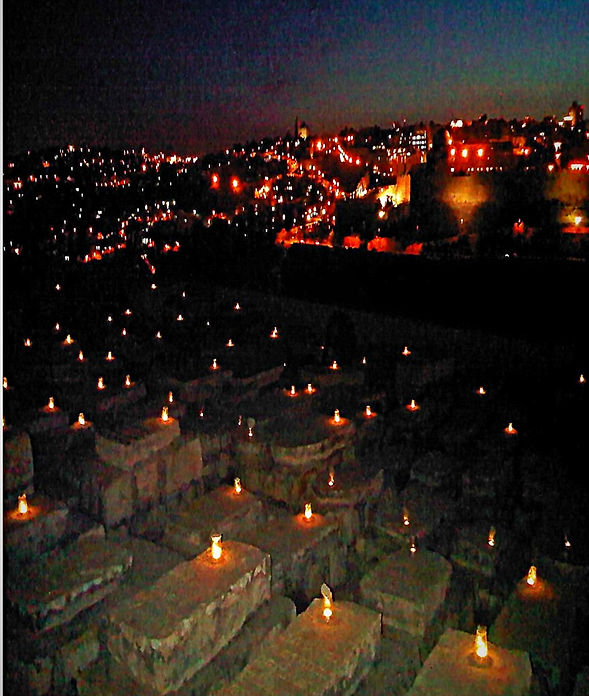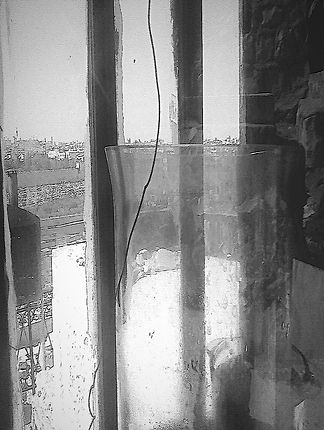When the Dead seize the Living
"When the Dead Seizes the Living"
"Once again, the accuracy of the ancient legend appeared to me; the heart of man is a pit filled with blood, on the edges of this pit the dearly departed throw themselves prone to drink the blood and reanimate themselves, and the dearer they are to you, the more blood they drink."
Nikos Kazantzakis
Concept: Internalization of the bodies of the deceased: death without a corpse buried within ourselves: body-tombs / body-symptoms / body-ghosts.
Perched on a hill in Jerusalem, the Mount of Olives cemetery (over 70,000 graves) lacks lighting, constituting a black hole, a visual gap within the nocturnal landscape of Jerusalem. In this performance, I scripted the relationship between the dead and the living through the relief of the landscape's topography by lighting (igniting two thousand candles) and the recitation by Or Avishai of names inscribed on the steles as well as names read by Rawan Hossin of the inhabitants of the villages of "Silwan", "Djebel and Zeitung", "Hassel Hamoud", "El Tur and "El Eizariya". The video is constructed on a single long take to establish a visual and auditory continuity between the cemetery and its surrounding environment (Mount of Olives, separation wall, view of the old city, etc).
The recitation of epitaphs, whose formal framework is highly codified, is not decipherable by all. They are often apologetic and can include poems, praises from the corpus of Hebrew tradition. Inscribed on each grave, they synthesize the quintessence of the lives of the deceased (name, place of birth, familial ties, lifespan, profession). In this, they are addressed to the living for whom they constitute a symbolic and transitional textual space.
"Facing the Living
(Mount of Olive Cemetery, 2011)
"Facing the Living" (Mount of Olive Cemetery, 2011)
Tombs of letter-waves, oceanic text, sea of signs גל-אות (gal-ot) ocean of meaning and the exile גלות (gallouth) echo each other through their sonic resemblances. Exile is thus first and foremost the exile of meaning, that is, a place where the sign is cut off from its meanings. Wave of signs (gal-ot) is here associated with a sea of testimonies אלעד (gal-Ed). In this final place, sea of signs and an ocean of meaning are deposited like a gathering of exiles. In monotheistic traditions, messianic perspectives make the Mount of Olives the gathering place of humanity at the end of times. Inscriptions on the tombstones of names of shtetls destroyed during the Shoah whose trace has been erased from all geographical maps only appear here and by displacement can become contiguous to Hassel Hamoud just as Lodz can suddenly neighbor Kabul. Strange world maps these geographical palimpsests half-fictional, half-real where the meanings of the names of the living and the dead create the possibility of a reading of the landscape in abyme or a landscape opens another landscape. Through the reading of these Arabic and Hebrew names, I bring back from "those elsewheres" evocations of landscapes that escape the description of a landscape with national symbolism: "We learn from place to place and from place in flight; from flight to flight and from flight to border; from border to border; from the border to the beyond and from the beyond of beyond" [2]. Thus, the names mimic journeys, icons of exile (in Hebrew there (sham) שם and the name (shem) שם, share the same lexeme). The stranger, the displaced, and the exile have their place here. The mental landscapes evoked by the polyphony of the different soundtracks spatialize the landscape. Implicitly, the terraced relief of the Mount of Olives surfaces through the punctuation: breaths, gasps, and silences of the by-way of these epitaphs, or space of a duo between a muezzin and lullabies in Yiddish or even a refrain borrowed from the Talmud to animate with their musicalities the 'house of the living'.
This other cartography projects Jerusalem towards other horizons through common meanings created on the basis of names, a "poésis" communication that allows reciprocally weaving the bonds of belonging to the same human community (sometimes Jews and Arabs have borne the same name because they came from the same place). Thus described by the names of the city's inhabitants, dead and living alike, countries can become landscapes again populated with names of places, animals, plants, and feelings (example: Arab titles of civility beginning with Abu (Father) such as: "Mr. Father of the Sheep", "Father of the Pomegranate", "Father of the Abbasid Kingdom", "Father of Spring", "Father of the Wolf", "Father of the Hyena", "Father of Bet Sarour", "of the Light", "of the Moon", "of Egypt", "of Peace", "of Silwan", "of Syria", "of St John of Acre", "of the Cricket", "of the Hyssop", "of Bethlehem", "of the Sparkling Volcano", "of Baghdad", "of Tunis", "neighbor of God", "of Abu Gosh", "of the Stranger from the West". These names find their counterpart in Jewish titles of civility such as: Mr. "Sky Blue" (Himmelblau), "Shining Herbs" (Finkielkraut), "Summer Friend" (Sommerfreund), "Summer Enemy" (Sommerfeind), "He Moaned" (Weinstein), "Branchy" (Zveighhaft) or even "Mirror Man" (Spiegelmann). In contrast, the physical and political Jerusalem is increasingly moving towards a Ghettoization, like a multicolored Chinese cloisonné.
Acknowledgments:
Charlette Shulamit Ottolenghi (first voice), Or Avishai (second voice), Rawan Hossin (third voice), Eppie Kreitner, Dr. Nadine Shenkar, Muli Friedman, Basam Get, Sarah Verees, Itai Marom, Rami Israeli, Jalil Aburundi, Chlomi Maya, Matan Rachmani, Yaki Markus, Eden Tssemar, Hana, Zvika Bar (Oran Company), Royal Academy of Brussels.
[1] Reliefs: Remains of the dead or a feast, bas-reliefs, and inscriptions.
[2] Babylonian Talmud, Eruvim 51A.

"Half-Glass"
(Cibachrome print. Format A4, 2011)
"Hour Glass"
(Life size sculpture, plaster, 2010)



